Snapping hip syndrome, also known as dancer's hip, is a medical condition where you feel a snapping sensation, or hear a snapping sound, in the hip when you are running, walking, or swinging your leg around. For many people, the problem is nothing than a nuisance, and the only symptoms are the snapping sensation and sound itself. However, for athletes or dancers, snapping hip exercises may help alleviate the weakness or pain that sometimes interferes with their performance.
Why does It Happen?
In many cases, the snapping symptom is a result of the movement of a tendon or muscle over the bony surface in the hip, and snapping hip syndrome is often the result of tightness in the muscles and tendons surrounding the hip.
Extra-Articular
- Lateral
The lateral site is located on the outside of the hip, where the iliotibial band (connective tissue), slides over the part of the thigh bone that juts out (trochanter), and is the most common site. When you stand upright, the band positions behind the greater trochanter; but when you bend over, the band slides in front and over the trochanter. And because the trochanter slightly sticks out, the movement of the band across it creates the snap you hear. - Medial
Another place where snapping occurs is at the top of the thigh bone where the ball that fits into the socket of the pelvis to form the hip joint. The snapping happens when the tendon (rectus femoris), running up through the pelvis and inside the thigh bone, moves across the ball when the hip joint is bent and then straightened.
Intra-Articular
Although less common, bits of broken cartilage, a cartilage tear, or bone in the joint may cause snapping hip syndrome, and sometimes a loose piece of cartilage may cause the hip to lock up. People with intra-articular snapping are more likely to describe a locking, catching, sharp stabbing sensation or painful clicking.
10 Snapping Hip Exercises
1. Piriformis Stretch
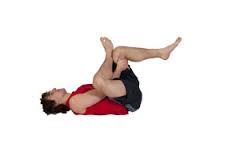 While lying on your back, bend both knees and place your foot from the uninjured leg flat on the floor and rest your ankle from painful leg over the knee of the uninjured leg. Take and hold the thigh of your uninjured leg and gently pull your knee toward your chest. Hold for 30-60 seconds and release. Repeat three times.
While lying on your back, bend both knees and place your foot from the uninjured leg flat on the floor and rest your ankle from painful leg over the knee of the uninjured leg. Take and hold the thigh of your uninjured leg and gently pull your knee toward your chest. Hold for 30-60 seconds and release. Repeat three times.
2. 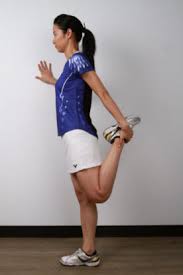 Quadriceps Stretch
Quadriceps Stretch
Start out by standing sideways at arm's length next to a wall with the injured leg farthest from the wall. Begin by looking straight ahead, and while propping yourself with one hand against the wall, take the other hand and grasp your ankle of the injured leg and pull the heel toward your buttocks. Keep your knees together, and don't twist or arch your back. Hold this position for 15-30 seconds. Repeat three times.
3. Hamstring Stretch (Wall)
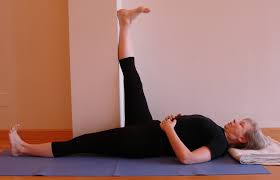
Lying on your back with your thighs near a doorway, stretch the uninjured leg straight out and through the doorway. Lift the injured leg, and keeping it as straight as possible, rest it against the wall near the door frame. Hold the stretch 15-30 seconds, and repeat three times.
4. 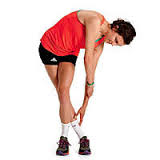 Standing
Standing
Cross the uninjured leg in front of your uninjured leg. While not bending your knees, reach down toward the inside of the back foot. Hold this stretch for 15-30 seconds. Then return to the starting point, and repeat 3 times.
5. Side Leaning
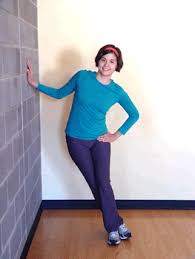 Side leaning is one of the snapping hip exercises that would help to relieve your pain and strengthen your weak muscles.
Side leaning is one of the snapping hip exercises that would help to relieve your pain and strengthen your weak muscles.
Stand next to a wall sideways with the injured leg nearest to the wall. Put your hand on the wall for stability, and cross the uninjured leg over the injured leg. Keep your foot flat on the floor and close to the wall, then lean the hips towards the wall. Hold this position for 15-30 seconds, and repeat 3 times.
6. Prone Hip Extension
 While lying face down, stretch the legs straight out behind you, resting your head on your folded arms beneath you. Draw your abdomen towards the spine and tighten your abdominal’s. Tighten your thigh and buttocks muscles of the injured leg and while keeping it straight, lift it up from the floor about 8 inches. Hold the position 5 seconds. Then lower the leg and repeat. Do two sets of 15.
While lying face down, stretch the legs straight out behind you, resting your head on your folded arms beneath you. Draw your abdomen towards the spine and tighten your abdominal’s. Tighten your thigh and buttocks muscles of the injured leg and while keeping it straight, lift it up from the floor about 8 inches. Hold the position 5 seconds. Then lower the leg and repeat. Do two sets of 15.
7. Hamstring Stretch (Lying Down)
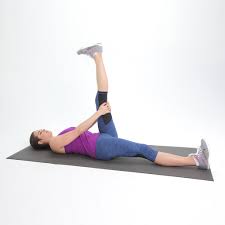 As one of the great snapping hip exercises, hamstring stretch not only helps to relieve your discomfort, it can also help to tone your body.
As one of the great snapping hip exercises, hamstring stretch not only helps to relieve your discomfort, it can also help to tone your body.
Lie on your back using a rolled up towel to help support your lower lumbar, and keeping your legs straight. Hold the back of your injured leg for support, lift up and toward your body until you feel the stretch. Hold the position for 30 seconds, and repeat 2-4 times.
8. Bridging
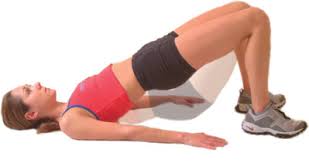 While lying on your back bending both knees at a 90 degree angle, place your feet flat against the floor, tighten the buttocks, and lift up your hips from the floor until the knees, shoulders and hips, form a straight line. Hold this position 6 seconds while breathing normally, then lower your hips down and rest for 10 seconds. Repeat 8-12 times.
While lying on your back bending both knees at a 90 degree angle, place your feet flat against the floor, tighten the buttocks, and lift up your hips from the floor until the knees, shoulders and hips, form a straight line. Hold this position 6 seconds while breathing normally, then lower your hips down and rest for 10 seconds. Repeat 8-12 times.
9. Alternate Arm And Leg (Bird Dog) Exercise
 Exercise.jpg) Note: Do this exercise slowly, and try to keep the body straight at all times.
Note: Do this exercise slowly, and try to keep the body straight at all times.
Begin on the floor, on your hands and knees. Tighten the abdominal’s by pulling your stomach in toward the spine. While breathing normally, raise your leg off the floor, and hold it straight out behind you. Try not to let your hip drop down, because that will twist your trunk. Hold the position about 6 seconds, then lower your leg and switch to the other leg. Repeat 8-12 times for each leg.
10. Clamshell
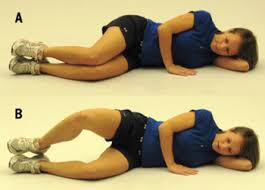 Position yourself on your side, with the injured leg on top and your head propped on your arm, while keeping the knees and feet together. Raise the top knee, remembering to keep your feet together. Don’t let the hips roll back, and the legs should open similar to a clamshell. Hold the position 6 seconds, and gently lower your knee down, and repeat 8-12 times.
Position yourself on your side, with the injured leg on top and your head propped on your arm, while keeping the knees and feet together. Raise the top knee, remembering to keep your feet together. Don’t let the hips roll back, and the legs should open similar to a clamshell. Hold the position 6 seconds, and gently lower your knee down, and repeat 8-12 times.
